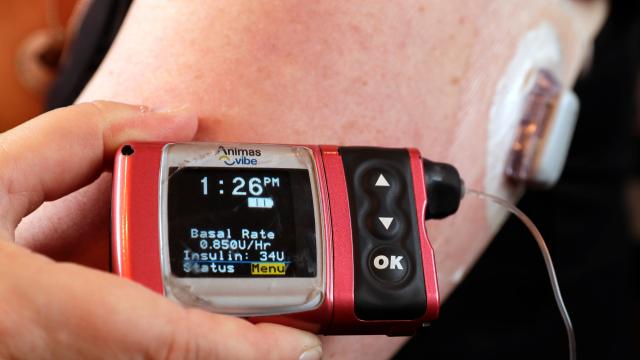Our conception of diabetes might be way off-base, a large international collaboration of researchers argue this month in The Lancet Diabetes and Endocrinology. Rather than just type 1 and type 2 diabetes, there could be at least five broad ways the insulin disorder manifests.
A women using an insulin pump. Image: David J. Phillip (AP Photo)
Diabetes is best understood as a breakdown of the process that maintains proper glucose levels in the body. Typically, the hormone insulin, produced in the pancreas, moves glucose from the bloodstream into your cells, where it’s converted into energy.
People with type 1 diabetes, as we traditionally understand it, have an immune system that attacks and destroys the cells that make insulin, rendering them permanently insulin-deficient. This condition typically shows up early in life. Those with type 2 diabetes, who make up around three-quarters of all cases, either stop producing as much insulin they once did, or they stop responding to the presence of insulin as easily.
(Other, secondary types of diabetes can involve insulin or other mechanisms).
In this latest study, the Swedish and Finnish researchers analysed the medical records of around 15,000 patients newly diagnosed with diabetes. The records were obtained from five patient registries established in both countries. They looked at six variables that are often used to determine the type and severity of a specific diabetes case, from the age of diagnosis to BMI to the level of insulin resistance.
They found there were clearly five distinct groups of patients that could be seen across every registry they examined. The first group basically fit the bill of type 1 cases: Young, otherwise healthy people whose insulin supply was demolished by their immune system. The remaining four groups could best be thought as subtypes of type 2.
There were patients whose cells also stopped producing insulin, but not because of their immune system; they were often young and in otherwise good shape. The third group was made of patients whose bodies kept making insulin but had stopped responding to it. These patients had the most severe symptoms (such as kidney damage), a very dysfunctional metabolism, and were typically overweight or obese.
Patients in the fourth group were also often overweight, but their bodies weren’t resistant to insulin, and they had milder symptoms and a healthier metabolism. The fifth group was made of patients who developed diabetes later on in life; they also had the mildest symptoms.
Breaking out these subgroups and recognising them as distinct types of diabetes could hopefully lead to better tailored treatment, the researchers say. People with severe insulin-resistant diabetes, for instance, could be treated more aggressively since they’d be at greater risk of developing serious complications.
“Current diagnostics and classification of diabetes are insufficient and unable to predict future complications or choice of treatment,” said lead author Leif Groop, an endocrinologist at the Lund University Diabetes Center in Sweden as well as the Folkhalsan Research Centre in Finland, in a statement. “This is the first step towards personalised treatment of diabetes.”
Other researchers caution that the team’s results need to be replicated elsewhere, using even more diverse patient samples. And there still are unanswered questions about how relevant these differences are.
“We also need to know if treating these groups differently would produce better outcomes.” Sudhesh Kumar, a professor of medicine at Warwick Medical School, told BBC News.
Groop and his colleagues next plan to develop a web tool that would help assign patients to specific clusters using the same variables, which is expected to aid both future research efforts and doctors treating patients now. It’s currently estimated that over 420 million people globally have diabetes, according to the World Health Organisation.
